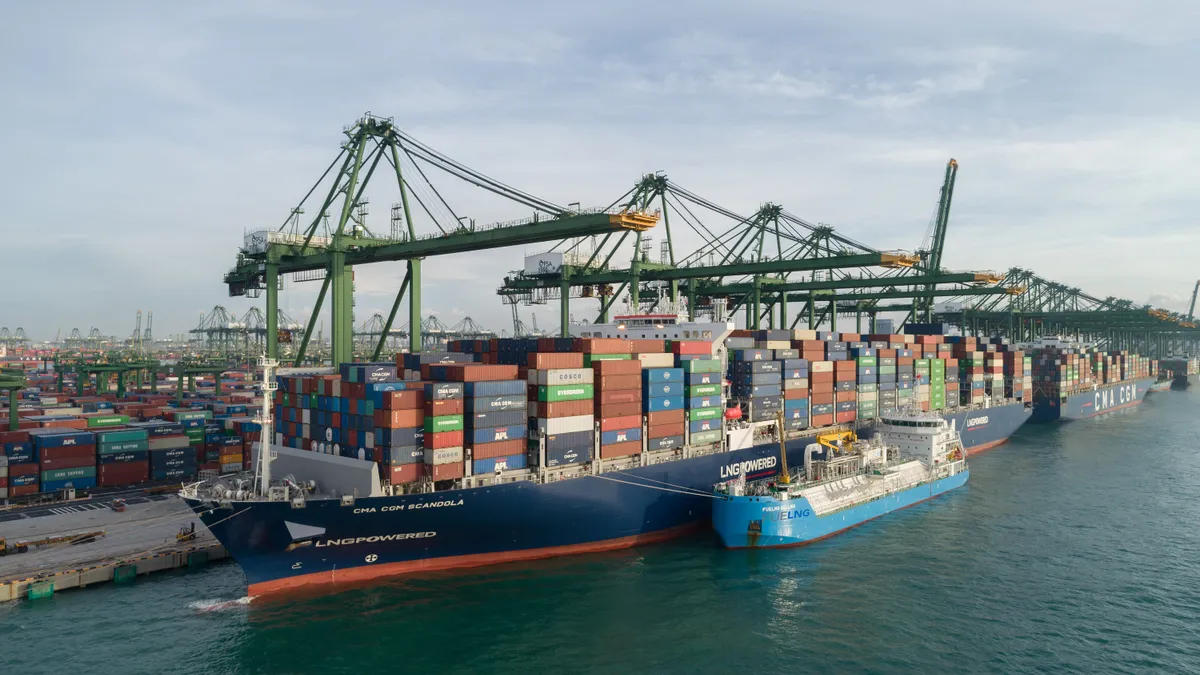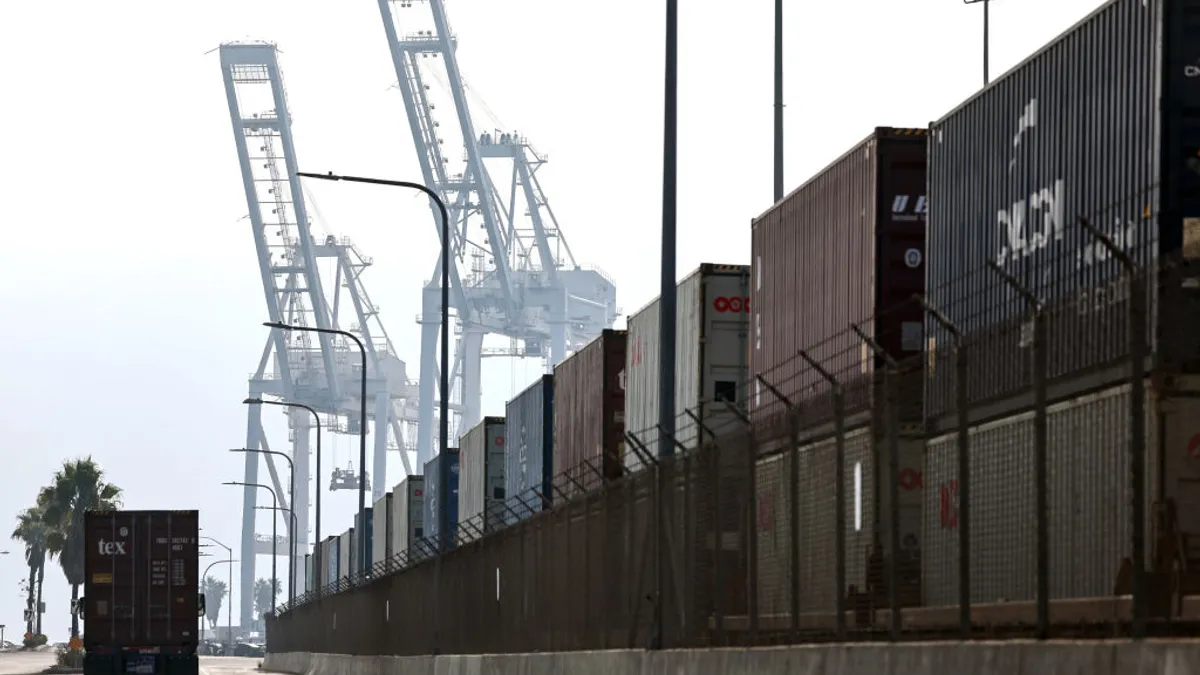Consumer demand and retail sales are up, way up, after 2020's many crucibles. While the delta variant of COVID-19 has thrown a shadow over the recovery, customers have been refreshing wardrobes, spending stimulus checks and going shopping.
If only the supply had bounced back as quickly as the demand. Bottlenecks have been building all along the supply chain, from raw materials to container ships, and are generally expected to continue throughout the holiday season.
With container shipping capacity down, and some Chinese ports disrupted by COVID-19 outbreaks, shipping prices have skyrocketed and wait times lengthened. The end effect is it has become a far more costly and uncertain enterprise just to bring goods into the country to sell to customers.
S&P Global Market Intelligence's Panjiva supply chain research unit found that aggregate import prices have increased in 14 out of the past 15 months. With a 0.3% month-over-month increase, July marked the ninth straight month of price increases. Shipping rates ticked up 0.5% in the first two weeks of August, and are up 18.9% in the second quarter of 2021 versus Q1.
Finding a retailer or brand unaffected by the supply chain bottlenecks is a difficult task. One relative exception is Canada Goose, which makes much of its product domestically (more on that below). For others, the supply chain chaos goes right to the heart of their operations. Margins, profits and performance outlooks for the year are taking hits.
Industry players have a range of tools to manage the difficulties. The largest retailers — Walmart among them — can charter ships to guarantee transportation of goods. Companies are also building longer lead times into their plans and using other forms of transport, including air cargo. (With so many firms turning to the skies at the same time, air cargo has its own bottlenecks, though.)
Many players are managing their costs and raising prices to offset supply chain woes. Among publicly traded retailers, the subject has come up in nearly every Q2 quarterly conference call retail executives have held with analysts and investors in recent weeks. Below are excerpts from some of the industry's major players on how they are managing the crisis:
Brett Biggs, Walmart CFO and executive vice president
Our merchants continue to take steps to mitigate challenges, including adding extra lead time to orders and chartering vessels specifically for Walmart goods. Out of stocks in certain general merchandise categories are running above normal, given strong sales and supply constraints.
Ted Decker, Home Depot COO and president
One of our values is entrepreneurial spirit, which is alive and well at The Home Depot. Our supply chain teams recently leveraged our scale and flexibility to arrange for several container vessels for our exclusive use. Yet another way our teams found a creative solution to better serve our customers in this dynamic environment.
Our in-stock levels are still not where we want them to be, we are maintaining the improvements we made over the last few quarters and building depth in key categories, as evidenced by inventory growing faster than sales compared to the same period last year...
There's a COVID outbreak in a factory, there's a shipping constraint, there's a domestic transportation capacity constraint. So it's been the story of two steps forward, one step back, but we are making progress. And that's why we're happy to lean into inventory.
We're blessed with the financial strength and liquidity. Our goods tend to be non-perishable, not a lot of obsolescence particularly in our core product.
John Mulligan, Target COO and executive vice president
Our team has been successfully addressing supply chain bottlenecks that are affecting both domestic freight and international shipping. Steps include expedited ordering and larger upfront quantities in advance of a season, mitigating the risk that replenishment could take longer than usual. Bottom line, with Q2 ending inventory up more than 26% or nearly $2.5 billion compared with the year-ago, we believe we're well-positioned for the fall and ready to deliver strong growth on top of last year's record increases.
Michael Fiddelke, Target CFO and executive vice president
Among other gross margin drivers, we saw about 70 basis points of pressure and merchandising, reflecting the impact of higher product and freight costs, partially offset by the benefit of low markdown rates.
Philip Krim, Casper Sleep co-founder and CEO
We continue to see very solid demand for our products, although the well-publicized industry-wide manufacturing and supply chain disruptions impacted our second quarter results ...
Specifically, despite expanding our base of third-party manufacturers earlier this year, our suppliers had less capacity than originally anticipated due to the persistent shortage of raw materials and components critical to mattress production as well as increasingly significant labor shortages and shipping constraints across the supply chain during the second quarter. These conditions had a greater-than-expected impact on our ability to meet all of the demand we receive and are creating stronger than forecasted inflationary pressures across much of our cost of goods sold. Absent these challenges, we believe that Casper would have been adjusted EBITDA profitable in the second half of 2021.
Scott Goldenberg, TJX COs. CFO
Our very strong sales and excellent merchandise margin increase more than offset the 150 basis points of incremental freight expense, the substantial supply chain and wage costs, and higher incentive compensation accruals ...
We believe the costs are still going up higher in the back half as ocean freight rates have in some cases gone up 200%, which we would expect in the third and fourth quarter. We don't think this level of freight deleverage, which will be more than that 150 at least what we're seeing now, will be at the sustained levels. If they are, that means the sales levels are going to continue because that means there's a tremendous demand.
Ernie Herrman, TJX CEO
But a couple of things that have been happening, the buyers when — if they're in a category where things are a little light, they've been pulling the trigger a little sooner and buying with longer lead times than we typically would .... So I really give them a lot of credit.
The logistics teams have been securing the freight capacity and we need to get the goods to our [distribution centers] and stores to meet our strong demand. And we're paying more when we need to. As always, and I know we've talked ... about this, we do that because we think we will figure out, as witnessed by what we're talking about today, we'll figure out later how to offset the costs, but we want to continue to gain the market share and gain customers for the future.
David Denton, Lowe's CFO and executive vice president
Supply chain costs also pressured margin by 35 basis points as we absorbed some elevated distribution costs and continued to expand our omnichannel capabilities. Our supply chain team continues to leverage our scale in carrier relationships to minimize the impact of these distribution costs experienced across the retail industry.
Jill Timm, Kohl's CFO
As it relates to the supply chain, it is a fluid and evolving situation. While we have experienced inventory receipt delays in many areas of the business due to temporary factory closures and port congestion, our women's business has a disproportionate exposure given its high penetration of private brands.
We are managing the situation aggressively, leveraging our diversified global supply chain to ship production, when and where appropriate, and to prioritize and expedite orders while also maintaining a high frequency of pickups at the ports and deliveries to our stores. Given the fluidity of the situation, we will remain agile and responsive with a focus on minimizing disruption.
Rob Helm, The Children's Place CFO
We continue to experience late deliveries and factory delays resulting from the continued disruption in the global supply chain, due to the pandemic, as well as increased costs for inbound ocean freight, due to equipment and container shortages. We are pulling up product receipts where possible and have been able to keep air freight costs to-date to a minimum. We anticipate that we will continue to see disruption in the environment at least until the end of 2021.
Jonathan Sinclair, Canada Goose CFO
Due to our unique model, we don't have significant exposure to the production shutdowns and shipping delays the sector is currently facing.
The vast majority of our revenue base is made in Canada. With a continuative offering, we confidently stage raw materials and finished goods. Our shipping routes are also different. We generally start outbound from Canada to our global network of distribution centers. We are highly confident in our ability to get product into the marketplace while retaining in-season flexibility.
Michael Hartshorn, Ross Stores COO
Worsening industry-wide supply chain congestion drove higher freight costs of 85 basis points ...
At some point, there will be some equilibrium in the freight world, especially with ocean freight that we expect to be an opportunity going forward. And then I would say, the return to 2019 margin levels will be highly dependent on strong sales performance over time.
Scott Roe, Tapestry CFO
As it relates to elevated costs that we're seeing, we are seeing some elevated costs primarily due to expedited freight, airfreight, essentially, as we absorb and deal with the supply chain disruptions that we see. And our outlook reflects additional airfreight really through the holiday period, which is as far as we can see in terms of getting the deliveries and trying to maintain the strong momentum we have ...
As we look to next [fiscal] year*, we are going to see elevated inventory positions, starting in the first quarter. And the reason for that is twofold. Number one, just supporting the growth of the business. Number two, we're expediting, as I said, what we can to bring in inventory, whether it be even by air or by sea, we're getting inventory in as fast as we can reasonably do in order to keep the momentum of the business.
And those factors together are going to be a slightly elevated increase in inventory, but I have no concerns about this at all. This is inventory that is supporting the trend of the business. And frankly, if we could get more, we probably would.
*Tapestry's fiscal calendar changes over in July.





















